
|
þ 20s |
Brazil’s first air route was inaugurated on February 3, 1927, at 8 AM o'clock. It was known as "Lagoon Line" for linking Porto Alegre, Pelotas and Rio Grande cities, with seaplanes that took off and landed in Lagoa dos Patos lagoon, in Rio Grande do Sul state. The flight lasted about 2 hours and 20 minutes at a cruising speed of 160km/h and an altitude of 20-50 feet. It was also VARIG’s first route VARIG operated with Dornier Wal “Atlântico”.


Linha da Lagoa (Lagoon Line)
|
þ 30s |
After the "Atlântico", the route was also operated by Dornier Merkur "Gaúcho". After the "Lagoon Line", VARIG expanded its routes to Rio Grande do Sul’s state interior cities. For this, the company adquired its firsts land aircraft, Junkers. In April 1932 VARIG started flights to Livramento, Santa Cruz, Cruz Alta e Santana do Livramento. With more Junkers aircraft, VARIG extended its routes to cities like Uruguaiana, Bagé, Santa Maria, San Ângelo, Rosário, Passo Fundo and Caxias do Sul.

VARIG route map in 1933
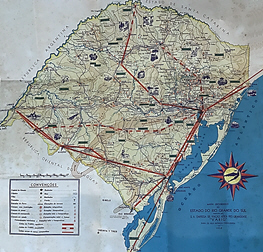
VARIG route map in 1938 (click to open)
|
þ 40s |
In the 40s, VARIG expanded its routes beyond borders of Rio Grande
do Sul state, arriving in cities in Santa Catarina and Paraná states
and also São Paulo and Rio de Janeiro. On August 5, 1942 VARIG
started its first international route, linking Porto Alegre to
Montevideo, capital of Uruguay. Shortly thereafter, the route was
extended to Buenos Aires, capital of Argentina.
After the Second World War, the German Junkers aircraft fleet was
replaced by American aircraft DC-3, C-46, Lockheed L10 and British
DH89.

VARIG route map in 1945

VARIG route map in 1949
|
þ 50s |
The acquisition of Aero Gal airlines, in May 1952, allowed VARIG extend its lines to the Brazil’s Northeast. With Curtiss C-46 and Douglas DC-3 aircraft, VARIG arrived in Vitória, Belmonte, Salvador, Aracaju, Penedo, Maceió, Recife, João Pessoa, Natal, Fortaleza, São Luis and Belém. In July 1953 VARIG inaugurated Rio de Janeiro - Buenos Aires nonstop route. But big news was the first intercontinental route to the USA with the luxurious Lockheed Super G Constellation. It was inaugurated in July 1955 on Buenos Aires - Montevideo - Porto Alegre - São Paulo - Rio de Janeiro - Belém - Trujillo - New York - Port of Spain - Rio de Janeiro - São Paulo - Porto Alegre - Montevideo - Buenos Aires route.

VARIG route map in 1952
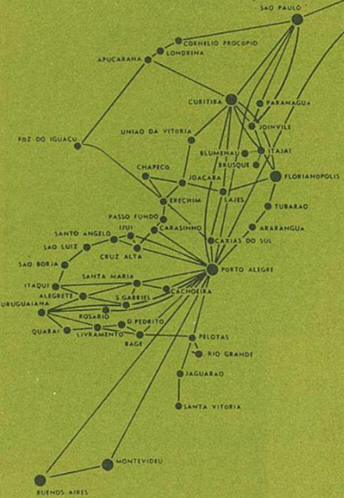


Regional
routes / Domestic routes / International routes
|
þ 60s |
Everything changed in September 1959 when VARIG’s Caravelle 1,
Brazil’s first jet, began to operate on Rio - New York route. With
jet aircraft, the flight time was reduced from 25 hours to 14 hours.
On June 22, 1960 the Boeing 707-441 started to operate this route,
making it even faster. Now Rio de Janeiro - New York route was made
in just 9 hours and nonstop. Due a reform on Rio de Janeiro
airport’s runway, the B707 made the route from Brasilia airport
temporarily, creating the route Brasilia - New York. However, Super
Constellation still shared the route to New York with the B707,
maintaining stops in the Caribbean.
After the acquisition of Real-Aerovias-Nacional airline, in August
1961, VARIG started to operate in various domestic destinations,
reaching more than 90 cities in Brazil. In international market, the purchase
enabled VARIG arrive in Lima, Bogota, Caracas, Mexico City, Miami
and Los Angeles.


Domestic routes / International routes
In February 1965 VARIG assume Panair’s routes to Europe. At that
moment, VARIG started fly to Lisbon, Madrid, Monrovia, Sal, Dakar,
Beirut, Rome, Zurich, Paris, Frankfurt, London and Santiago.
On the route to Portugal, called "Voo da Amizade", was operated by
Electra II and Super G Constellation, with cheaper fares, which made
stops in Recife and Ilha do Sal. Voo da Amizade lasted until the end
of the 60's.
The stopovers in Africa were merely to refuel the aircraft, which at
the time had no enough range. Monrovia and Dakar were the cities
used and these destinations left VARIG's route map in 1968, when
technology allowed nonstop flights between Brazil and Europe.
Another destination that did not last long was Beirut. VARIG took
over this flight originally operated by Panair, but the flight was
canceled in 1969.
In the Americas, in addition to starting flights to Chile, VARIG
also included Panama City on its route to Mexico City. The route to
New York was only with the nonstop flight from Rio de Janeiro, while
the stops in the Caribbean became part of the route to Miami.
Later, in 1968, VARIG expanded even more its international network,
inaugurating flights to Copenhagen and Tokyo. The flights were
operated to Copenhagen from Rio de Janeiro, with a stop in Rome and
flights to Tokyo, also from Rio and stops in Lima, Los Angeles and
Honolulu. Subsequently the stop in Honolulu was canceled in 1971.
Initially flights to Tokyo were operated twice a week. In 1970,
flights to Tokyo became three times a week and flights to Europe
reached twelve times a week.
At that time VARIG’s intention was to get around the world as Pan Am. So VARIG’s route to Japan was a step in that
direction.

International routes
|
þ 70s |
In the 70s, there was a major change in the Brazilian domestic market with the introduction of jet aircraft, regional routes were abandoned and VARIG began focus only in major cities. Seeing that, Brazilian federal government decided to create SITAR (National Air Transportation System). So, in 1976, VARIG established its subsidiary Rio Sul, which started operating regional routes in Rio Grande do Sul, Santa Catarina, Paraná and Rio de Janeiro states. Now with Rio Sul, VARIG abandoned once the regional routes, thus reducing the number of domestic destinations. However VARIG continued its policy of expansion its international lines and launched flights to Africa and expanded its presence in Latin America, the USA and Europe. In 1970 was inaugurated Rio de Janeiro - Luanda - Johannesburg route.
With the purchase of Real-Aerovias consortium airline, 1961, VARIG started serving more than 90 cities in Brazil and received more than one hundred DC-3, C-46, Convair 340/440, L1049 and DC-6 aircraft. Throughout the 60s and 70s, the number of domestic destinations served by VARIG gradually decreased. Most of the regional flights were not profitable and the new aircraft received by VARIG were too big for most cities in the interior. With the creation of Rio Sul in 1976, the regional routes were transferred to its subsidiary. VARIG's last regional aircraft, "Avro", was retired in 1978 and the company operated only the Boeing 727 and Boeing 737, in addition to Electra II on domestic flights.
In 1973, VARIG inaugurated flights to Porto, in Portugal, and Geneva, in Switzerland, this last one in partnership with Swissair. However, the route to Geneva only lasted until 1978. The purchase of Cruzeiro, in 1975, allowed VARIG to expand its routes in South America to Bolivia, Ecuador, French Guiana and Suriname. The big news of the 1970s was flights to Africa. The first destination was Johannesburg, South Africa, and Luanda, Angola, in 1970. In 1977, VARIG also started flights to Lagos, Nigeria, and to Cape Town, South Africa.



Rio Sul routes /
International routes /
Domestic routes
|
þ 80s |
In the 1980s there was a consolidation of the routes already operated by VARIG. In addition, there was a small expansion in the number of national destinations, mainly driven by Rio Sul, and new international destinations. The company started flights to Milan (1980), Amsterdam (1981) and Toronto and Montreal (1986). Other destinations that started to be served in the 1980s included Iquitos, Guayaquil (1979), Quito (1979), Bridgetown (1982), São José (1984), Abdjan (1984), Maputo and Barcelona (1987).
In the 80s VARIG inaugurated its international network at the new Guarulhos International Airport in São Paulo. The first flight was from New York, operated by Boeing 747. The first non-stop international flights departing from São Paulo were to Paris, Amsterdam, Frankfurt, London and Zurich. These flights made a "triangular flight", where they also included Galeão airport in Rio de Janeiro. As VARIG's main facilities were in Rio, the company took a long time to transfer flights to Guarulhos airport in São Paulo. In 1989, most international routes still left Rio de Janeiro. That year, directly from São Paulo, VARIG had flights to Miami, New York, Los Angeles, Lisbon, Zurich, Frankfurt and Paris, in addition to all Latin America destinations.
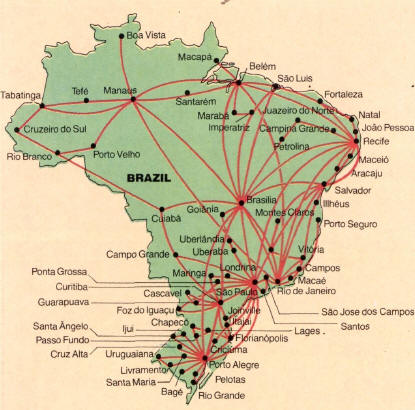
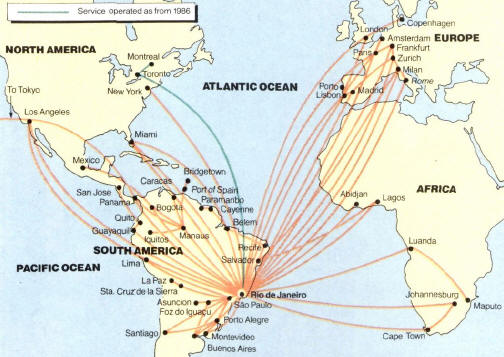
Domestic routes / International routes
|
þ 90s |
In the early 1990s, VARIG reached the largest number of international destinations served in its history with the launch of routes to Georgetown and Chicago in 1990, San Francisco in 1991, Cancun in 1992, Atlanta in 1994, Córdoba, Rosario, and Orlando in 1996, and Washington in 1997. In 1991, VARIG also expanded flights to Japan, flying to Nagoya, and, in 1992, launched its longest route: Rio - São Paulo - Johannesburg - Bangkok - Hong Kong. Some routes did not last long, as Georgetown, canceled in 1992 and Chicago, canceled in 1994.
In 1995, VARIG acquired Pluna (Uruguayan airline), expanding its routes from Montevideo to Punta del Este, Buenos Aires, Asunción and Santiago de Chile. To Brazil, Pluna had direct flights from Montevideo and Punta del Este to Porto Alegre and São Paulo. The company also had a flight between Montevideo and Rio de Janeiro, which also continued to Madrid, operated with DC-10 and later with Boeing 767.
In the domestic market, Rio Sul was responsible for the expansion.
During the 90s, VARIG Group invested heavily in its regional
subsidiary, which acquired Boeing 737 and ERJ-145, and crossed
Brazil's South and Southeast borders, after buying Nordeste Linhas
Aéreas in 1995, reaching the Northeast and North regions as well.
However, the 90's also marked the beginning of VARIG's network
reduction. The company began to cut unprofitable routes. In Latin
America, Panama, San José, Quito, Quayaquil, Paramaribo, Cayenne and
Port of Spain routes were canceled. In Africa, virtually all routes
were canceled. The route to Maputo had already been canceled in
1987. The route to Abdjan was canceled in 1991 and until 1994
Luanda, Lagos and Cape Town were also canceled, leaving only
Johannesburg. In North America, the route to Montral was canceled in
1989. The route to Toronto lasted until 1994, marking the end of
flights operated by VARIG in Canada. In Europe, VARIG canceled
flights to Barcelona in 1994.
The 1990s there was also a strongest transition of international flights from Rio de Janeiro to São Paulo. Between 1990 and 1993 VARIG launched direct flights from São Paulo to Mexico City, Toronto, Cancún, Madrid, Milan, Rome and Johannesburg.
1999 was marked by a devaluation of the local currency against Dollar and a decline in passenger demand. In that year, flights to Porto, Atlanta, Orlando and Washington were canceled, in addition to the company's longest route to Bangkok and Hong Kong (in 1998).

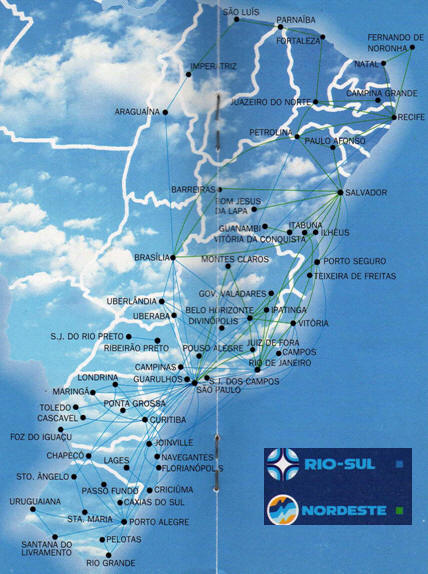
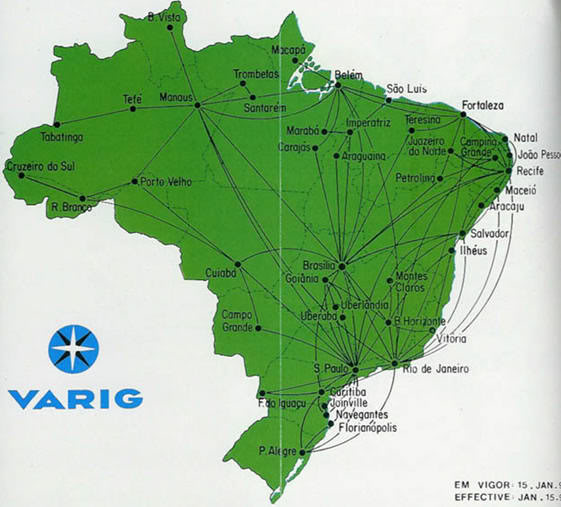
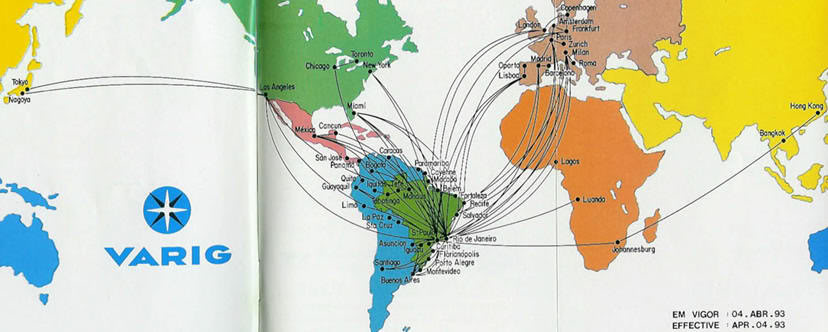
Pluna's route map /
Domestic routes VARIG, Rio Sul and Nordeste / International routes
|
þ 2000s |
The 2000s started with the rationing of domestic and international networks. Now that VARIG was part of the Star Alliance, the company could reach more than 124 countries with Code-Share agreements. This allowed VARIG to reduce the number of international destinations, but continued to sell tickets for these and many other destinations on flights operated by partner airlines. This was done with destinations such as Johannesburg, Cape Town, Toronto, Washington, Porto, Barcelona, Rome, Munich and Zurich.
Even though, VARIG inaugurated some new destinations in the 2000s, such as Munich (2000), Mendoza (2001) and Aruba (2004). The route to Munich was operated only until 2001. In 2005 it was resumed again and remained in the network until the end of operations in 2006. The route to Mendoza lasted only until 2002. On the other hand VARIG stopped flying to Zurich and Johannesburg (2000), Rome (2001) and Rosario (2002). In 2004, VARIG resumed flights to Johannesburg and Cape Town, but they lasted only a few months before being canceled again.
In addition, international flights are increasingly concentrated in São Paulo. VARIG had many direct flights between Brazil's Northeast and the USA and Europe, such as between Salvador and Miami, Lisbon, Madrid, Paris and Milan; Recife and Lisbon; Fortaleza and Milan; Belém and Miami; Manaus and Miami. All of these routes were canceled until 2004. Rio de Janeiro, which still had many nonstop flights between the USA and Europe, also lost almost all. The only ones who resisted until the end were for Frankfurt and Madrid (operated by Pluna). Non-stop flights from Rio to New York, Lisbon, Milan and London were canceled in 2000. Flights to Miami and Paris were resumed and canceled a few times, until they were definitively canceled.
The domestic network was also shrinking. In 2002, with the end of Embraer EMB-120 operations, through Rio Sul and Nordeste, some inland cities stopped being served as: Rio Grande, Pelotas, Santa Maria, Uruguaiana, Chapecó, Criciúma, Lages, Cascavel, Toledo, Maringá, Presidente Prudente, Campos, Governador Valadares and Parnaíba. In 2003/2004, VARIG merged with Rio Sul and Nordeste, and therefore the domestic network was completely reformulated. Embraer ERJ-145 fleet stopped operations in 2005, removing most cities in the interior from the network. In December 2005, VARIG had flights to only 36 destinations in Brazil, against 48 in December 2004 and 78 destinations in December 2001 (considering Rio Sul and Nordeste).
In 2005, VARIG cut a few more international destinations like Córdoba, La Paz and Nagoya. In 2006 VARIG ended its flights to Japan, ceasing to serve Tokyo. In other hand, the company started flying to Beijing, on the São Paulo - Munich - Beijing route, in partnership with Air China.
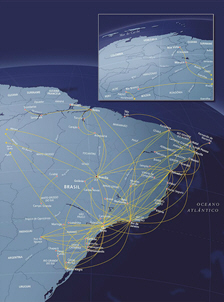
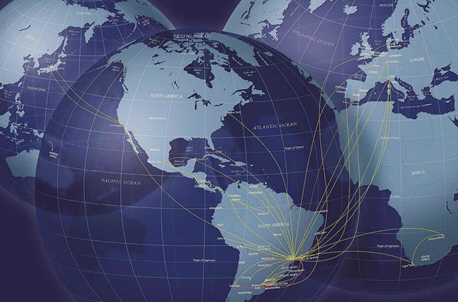
Domestic routes / International routes
|
Route Maps 2000s > 2000 > 2002 (international) > 2003 |

VARIG's international destinations since its foundation




